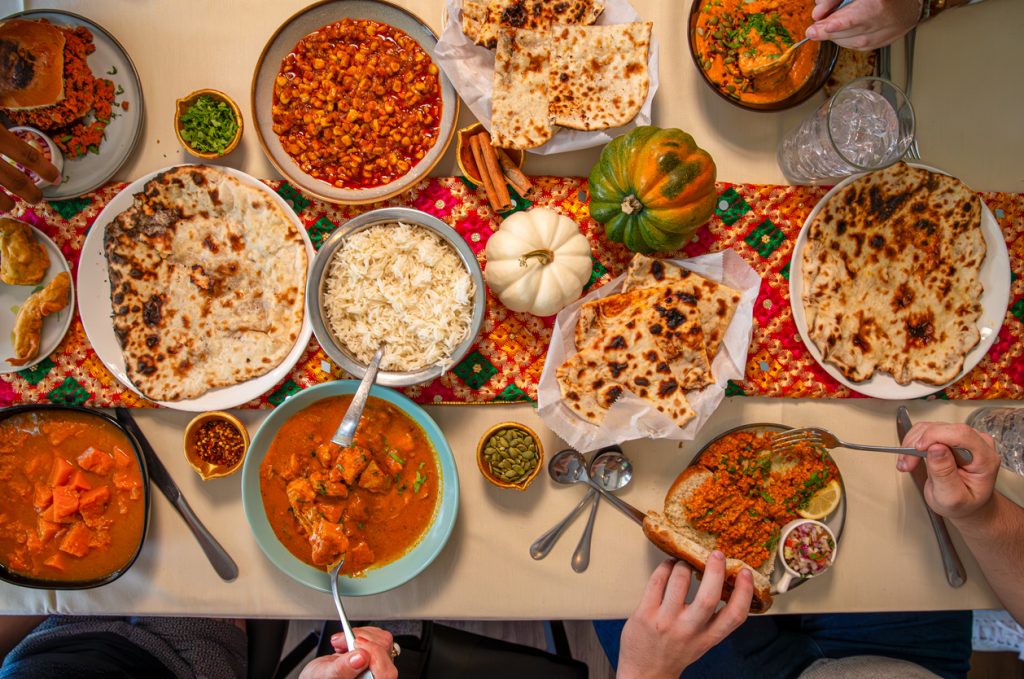Comfort food means something different to everyone. For some, it’s a creamy bowl of pasta. For others, it’s warm soup or a familiar dish made the same way every time. In Indian cuisine, comfort food is deeply tied to memory, routine, and tradition. These are meals cooked in home kitchens, shared at celebrations, made for guests, and prepared for quiet nights in.
Indian comfort food isn’t just about flavor. It’s about warmth, familiarity, and the feeling of being cared for.
Why Indian Comfort Food Feels So Meaningful
In many Indian households, the cooking process is full of rhythm: sautéing onions, stirring tomatoes until they soften, and adding spices at just the right moment. These steps form the base of countless dishes across regions.
But comfort food in India is not one flavor profile — it’s a spectrum:
- Some dishes are creamy and mild.
- Some are bright and tangy.
- Some rely on slow-cooked depth.
More importantly, many of these dishes carry emotional weight. They remind people of home, family, and familiar moments — the first meal back after traveling, a childhood dinner, or something warm prepared on rainy days.
Three Dishes That Tell the Story of Comfort
Chicken Tikka Masala
Chicken Tikka Masala is recognized today as a dish deeply connected to Indian cuisine, but its development is tied to the South Asian diaspora. Most culinary historians agree that the dish took shape in the United Kingdom in the late 20th century, where South Asian chefs adapted tandoori-style chicken by serving it in a tomato-based gravy to meet local preferences for saucier dishes.
Rather than representing one regional tradition, it reflects the way flavors evolve as people migrate and cook for new audiences. Today, it remains one of the most searched and most recognized Indian dishes globally because of its balanced spices and familiar, comforting richness.
Channa Masala
Channa Masala is a dish made with chickpeas simmered in a seasoned tomato and onion base. Variations of chickpea stews appear throughout North Indian and Punjabi home cooking, as well as in regional street-food traditions.
Its appeal comes from its versatility: it can be served with rice, roti, puri, or naan, and ingredients may change slightly depending on household customs or region. Channa Masala represents the kind of everyday cooking that many families grow up with — straightforward, warming, and satisfying.
Saag Paneer
“Saag” refers broadly to leafy greens that have been cooked down to a soft, velvety texture. Saag-based dishes have long been part of culinary traditions in North India and the Punjab region, where greens like spinach, mustard greens, and fenugreek are commonly grown. Paneer — a fresh, non-aged cheese — is a staple across many Indian cuisines because it can be prepared simply at home.
Saag Paneer brings these elements together: mild flavors, gentle spices, and a creamy texture that many people associate with home and comforting meals. It is a dish rooted in agricultural life, seasonal cooking, and family table traditions.
How Traditional Comfort Dishes Adapt to Modern Lifestyles
Many Indian comfort dishes are rooted in cooking methods that take time — simmering sauces, blooming spices in hot oil, and preparing fresh aromatics like ginger, garlic, and onions. These steps aren’t just technique; they’re part of how depth, warmth, and familiarity develop in the final dish.
However, preparing these meals from scratch can be challenging in daily routines. Long work hours, limited kitchen space, and a growing reliance on quick meal solutions mean that not everyone can always devote time to full stovetop cooking.
This is where ready to eat Indian food and other prepared meals come into the picture. They allow people to experience dishes like Channa Masala, Saag Paneer, and Chicken Tikka Masala without needing extensive prep time or a large spice collection at home.
Comfort, Routine, and Familiarity
Comfort food often provides a sense of grounding. Warm meals with layered spices and soft textures can create a feeling of stability and pause — especially on busy days.
People may choose easy Indian food or easy Indian food to cook options when they want:
- A warm lunch between meetings
- Dinner that doesn’t require multiple steps
- Flavors that feel soothing and familiar
- A simple way to introduce Indian dishes to new eaters
Many Indian dishes are also naturally adaptable to different lifestyles and dietary needs. For example, those searching for gluten free foods may find options made with rice, legumes, and vegetables — ingredients already common in many Indian regional cuisines.
A Warm Bowl, A Quiet Moment
No matter how it’s prepared, comfort food often holds meaning through experience:
- The aroma that fills a kitchen
- The warmth of the bowl in your hands
- The familiarity of spices you’ve tasted before
Sometimes that comfort is cooked slowly in a family kitchen. Sometimes it simply arrives ready to heat and enjoy. In either case, the heart of the meal remains the same: warmth, familiarity, and a sense of home, one bowl at a time. And that’s what inspires every Cafe Spice meal. Our ready to eat Indian food is influenced by dishes that have been loved for generations — meals that bring ease and comfort to everyday life.



